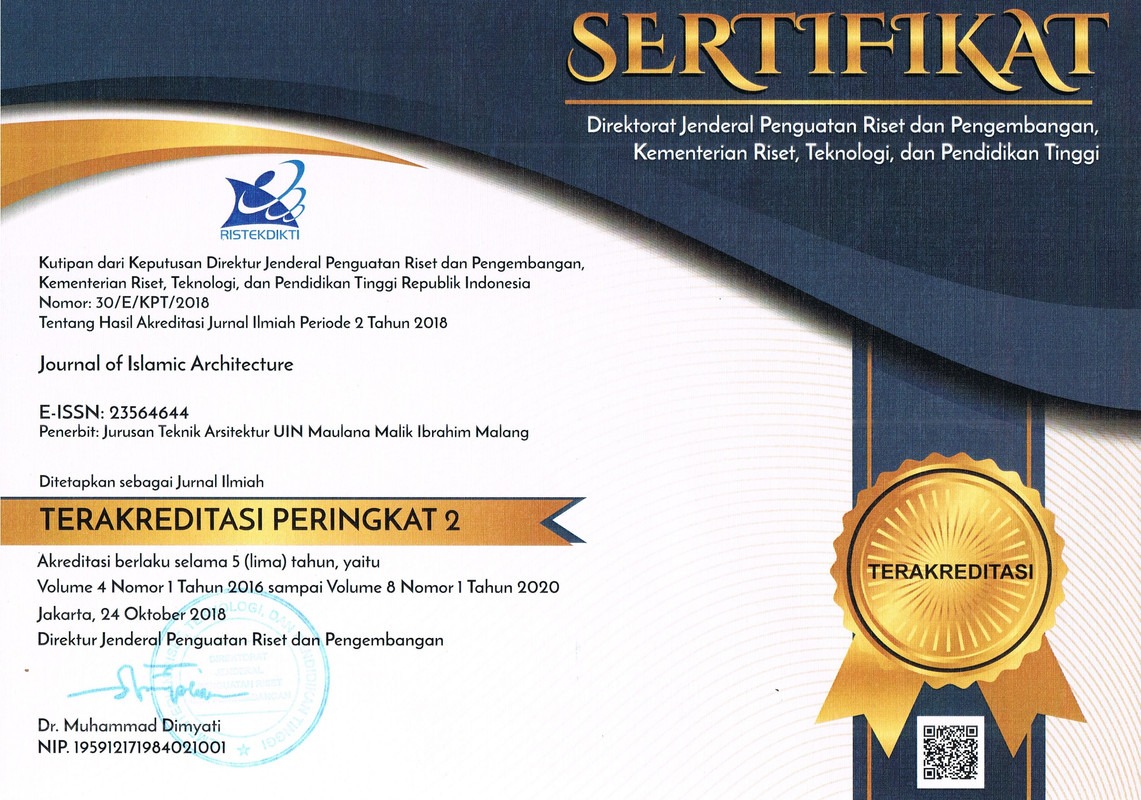ARCHITECTURAL INTROSPECTION OF ISFAHAN JAME MOSQUE IN ADAPTION TO THE UNSEEN CONCEPTS OF PERSIAN LYRICS (10-12th SHAMSI)
Abstract
The language of paraphrase (taa’wil, In Arabic: تاویل ) uses divine unseen (gheiybi, غیب) signs to shape the mosque institution. There are mosques and praying rituals for all realms: Literal (Mulki, مُلکی), Ethereal (Mithaali, مثالی), and Spiritual (Malakuti, ملکوتی). The rituals accomplish in mosque architecture in the hierarchy of being. The authority helps to explain the unseen concepts by paraphrase. The research questions are what factors have led to the manifestation of hidden ideas in the architecture of the Isfahan Jame Mosque objectively? And what are the evidence of unseen confirmations which led to introspection and personal approach? This research aims to answer the questions raised, then used a qualitative research method and describes the case study by using an analytical-introspective survey in combination with grounded theory to elucidate unseen concepts as esoteric meanings of architecture, in place and time. Numerous issues of the invisible architecture of mosque explain how to convert this mosque to desirable ones in the future. The architecture of the Jame Mosque of Isfahan is a live example of unseen architecture. It has a close relationship with esoteric literature of not only its era but also for all periods of history. Issues of the invisible architecture of the mosque explain how to convert this mosque to desirable ones in the future.
Keywords
Full Text:
PDFReferences
M. Motahari, Unseen Helps, Tehran: Sadra, 1975.
M. MadadPour, Onsi Wisdom and Mystical Aesthetics of Islamic Art, Tehran: Sureh Mehr, 2010.
A. Samer, Cosmology and Architecture in Premodern Islam, S. H. Nasr, Ed., New York: State University of New York Press, 2005.
H. Zomorshidi, Sacred Architecture, Tehran: Zamaneh Publishing, 2014.
H. Bolkhari Ghohi, The Story of Art in Islamic Civilization, Tehran: Soureh Mehr Publications, 2009.
O. Grabar, Great Mosque of Isfahan, Tehran: Mani, 2005.
R.A.G.O.Ettinghausen,Islamic Art and Architecture, Tehran: Mola, 2012.
F. Shafiyan Daryani, M. Pourjafar and A. Ghobadi, "The Concept of Persistence in Islamic Architecture and comparing it to the Concept of Sustainability in Contemporary Architecture," Researches of Islamic Architecture, pp. 32-52, 2019.
C. Vidal, Wat is een wereldbeeld? (What is a worldview?), N. Denken, Ed., Leuven: Acco Press, 2008.
M. Mesbah Yazdi, Teaching Philosophy, vol. 2, Qom: Imam Khomeini Educational and Research Institute Publications, 2012.
M. Ataei Hamedani, M. Hamze-Nejad and A.-H. Noghrehkar, "A Study about the Location of Mosques in Medina during the Era of Prophet Mohammad (PBUH)," Baghe Nazar, vol. 16, no. 8, pp. 3-16, 2011.
M. Ali Abadi, "The position of reason in the concept of sustainable city, another look at the theoretical foundations of Islamic architecture and urban planning," Architecture Studies, vol. 1, no. 1, pp. 25-38, 2012.
M. R. Soleimani, I. Itesam and F. Habib, "Recognition of the Concept and Principles of Identity in Architecture," Hoviat e Shahr, vol. 10, no. 25, pp. 15-26, 2014.
T. Ismail, Al-Amara and Al-Amrān-i-Zilal, Al-Quran, Tehran: Ajand, 2012.
Y. Hamedani, Rotbat ol-Hayat, Tehran: Toos, 1983.
V. Künnapu, "Louis Kahn and the images of eternal architecture," 15 01 2013. [Online]. Available: http://ehituskunst.ee/vilen-kunnapu-louis-kahn-and-the-images-of-eternal-architecture/?lang=en. [Accessed 28 01 2016].
R. Hillenbrand, Islamic Architecture, Tehran: Rozaneh, 2001.
V. Künnapu, "Louis Kahn and the images of eternal architecture," 15 01 2013. [Online]. Available: http://ehituskunst.ee/vilen-kunnapu-louis-kahn-and-the-images-of-eternal-architecture/?lang=en. [Accessed 28 01 2016].
J. Massoud, "Al-Farabi Alphabet Encyclopedia of Ar-Raa"; ed, Arabic-Persian, vol. 1, Mashhad: Astan Quds, 1983.
J. Massoud, "Al-Farabi Alphabet Encyclopedia of Ar-Raa"; ed, Arabic-Persian, vol. 2, Mashhad: Astan Quds, 1983.
S. Hosseini Kazerouni and S. Hamidi, Encyclopedia of terms and expressions of Hafez's Divan, Tehran: Armaghan Press, 2006.
M. Motahari, Spiritual Freedom, Tehran: Sadra, 1982.
M. Tabataba'i, Interpretation of Al-Mizan, vol. 1, Qom: Society of Teachers of Qom, 1996.
M. Ghera'ati, Interpretation of Light, Tehran: Cultural Center Lessons from the Koran., 2010.
A. M. Maraghi, Interpretation of al-Maraghi, vol. 1, Beirut: Dar Al-Fakr, no Year.
M. Roshandel, Moghtatif Interpretation, No place: No Press, 1367AH.
M. Heidegger, Existence and Time, Tehran: Phoenix, 2009.
M. Mesbah Yazdi, Teaching Philosophy, vol. 2, Qom: Imam Khomeini Educational and Research Institute Publications, 2012.
V. Taghvaii, "From Time to Timelessness in Human and Architecture," Urban Architecture Letter, pp. 117-122, 2010.
M. Heidegger, Existence and Time, Tehran: Phoenix, 2009.
B. Abolghasemi, Specialized Culture of Psychology, Psychiatry and Educational Sciences, Tehran: Arwij, 2009.
C. Goulding, Grounded Theory : A Practical Guid for Management, Business and Market Researchers, London: SAGE Publication, 2005.
Aristotle, De Anima, D. Ross, Ed., Oxford: Oxford University Press, BCE /1961.
E. Schwitzgebel , "Introspection," 02 02 2010. [Online]. Available: https://www.plato.stanford.edu. [Accessed 14 02 2019].
DOI: https://doi.org/10.18860/jia.v6i1.6001
Refbacks
- There are currently no refbacks.






